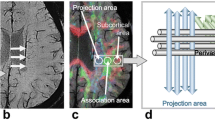Abstract
Isovaleric acidaemia is an inborn error of leucine metabolism due to deficiency of isovaleryl-CoA dehydrogenase, which results in accumulation of isovaleric acid in body fluids. There are acute and chronic-intermittent forms of the disease. We present the cranial CT and MRI findings of a 19-month-old girl with the chronic-intermittent form of isovaleric acidaemia. She presented with severe metabolic acidosis, hyperglycaemia, glycosuria, ketonuria and acute encephalopathy. Cranial CT revealed bilateral hypodensity of the globi pallidi. MRI showed signal changes in the globi pallidi and corticospinal tracts of the mesencephalon, which were hypointense on T1-weighted and hyperintense on T2-weighted images.


Similar content being viewed by others
References
Fries MH, Rinaldo P, Schmidt-Sommerfeld E, et al (1996) Isovaleric acidemia: response to a leucine load after three weeks of supplementation with glycine, L-carnitine, and combined glycine-carnitine therapy. J Pediatr 129:449–453
Tanaka K, Budd MA, Efron ML, et al (1966) Isovaleric acidemia: a new genetic defect of leucine metabolism. Proc Natl Acad Sci 56:236
Sweetman L, Williams J (2001) Branched chain organic acidurias. In: Scriver C, Beaudet A, Sly W, et al (eds) The metabolic and molecular basis of disease. McGraw-Hill, Philadelphia, pp 2125–2163
Budd MA, Tanaka K, Holmes LB, et al (1967) Isovaleric acidaemia. Clinical features of a new genetic defect of leucine metabolism. N Engl J Med 227:321–327
Shigematsu Y, Sudo M, Momoi T, et al (1982) Changing plasma and urinary organic acid levels in a patient with isovaleric acidemia during an attack. Pediatr Res 16:771
Tokatli A, Coskun T, Ozalp I (1998) Isovaleric acidaemia: Clinical presentation of 6 cases. Turk J Pediatr 40:111–119
Williams KM, Peden VH, Hillman RE (1981) Isovaleric acidemia appearing as diabetic ketoacidosis. Am J Dis Child 135:1068
Attia N, Sakati N, Al Ashwal A, et al (1996) Isovaleric acidemia appearing as diabetic ketoacidosis. J Inherit Metab Dis 19:85
Brismar J, Ozand PT (1994) CT and MR of the brain in the diagnosis of organic acidemias. Experiences from 107 patients. Brain Dev 16:104–124
Van der Knaap MS, Walk J (1995) Myelin, myelination and myelin disorders, 2nd edn. Springer, Berlin Heidelberg New York, pp 192–230
Fischer AQ, Challa VR, Burton BK, et al (1981) Cerebellar hemorrhage complicating isovaleric acidaemia: a case report. Neurology 31:746–748
Author information
Authors and Affiliations
Corresponding author
Additional information
An erratum to this article is available at http://dx.doi.org/10.1007/s00247-006-0252-9.
Rights and permissions
About this article
Cite this article
Sogut, A., Acun, C., Aydin, K. et al. Isovaleric acidaemia: cranial CT and MRI findings. Pediatr Radiol 34, 160–162 (2004). https://doi.org/10.1007/s00247-003-1049-8
Received:
Revised:
Accepted:
Published:
Issue Date:
DOI: https://doi.org/10.1007/s00247-003-1049-8




